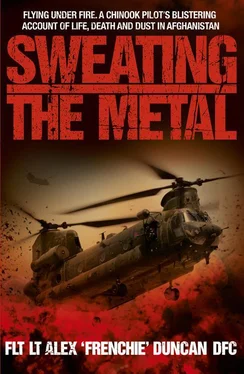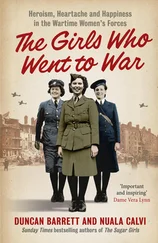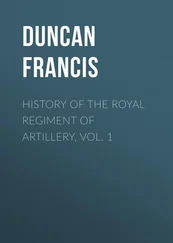‘I landed the aircraft next to Nightingale HLS at 17:00 to keep the landing site clear and allow access by other call signs. Then I gave clearance for the ramp to be lowered and Paul Day then gave me a running commentary as the casualties were taken off. Aware that I wanted to shut down as soon as possible, both he and Tony assisted with the off-load. They let me know as soon as the ambulances were clear and I shut down. As I climbed out of the cockpit I was immediately supported by the medics who led me off the aircraft and onto an ambulance where I was taken to hospital. I needed twelve stitches in my head, new body armour to replace mine, which was completely soaked in blood, and a new helmet. My shot-up helmet now has pride of place in the Mess.
‘The whole crew were brilliant in how they pulled together. In fact, there were several times where Doug, Paul and Tony all went above and beyond the call of duty. Doug’s actions were well ahead of what you’d expect from someone on his first tour, working under the constant possibility of having to recover the aircraft alone. Paul and Tony also acted beyond expectations and put themselves in harm’s way, assisting the medics and casualties, despite enemy fire landing close to them.
‘This is a team I was proud to work with.’
39
ABOVE AND BEYOND THE CALL
Alex Townsend, who had been my co-pilot throughout the missions for which I received the DFC, was back out in theatre in 2010 as an experienced captain, and coming under fire himself. He later received a Queen’s Commendation for Bravery (QCBA) and was given the Hugh Gordon-Burge Memorial Award by GAPAN for his actions on a number of sorties that he flew in February.
About three weeks earlier, on January 22nd, his cab took rounds when he was flying the IRT on a mission to pick up Rifleman Peter Aldridge of A Company, 4 Rifles who had been blown up by an IED while on patrol to the north of Sangin. Alex landed next to Peter’s colleagues while they were engaged in a firefight, and just as Rifleman Aldridge was loaded, the cab was hit by several 7.62mm rounds, one of which Alex later picked up – it now lives in his room. The Apache providing escort for him was also hit, although none of the rounds hit vital systems or caused injury on either aircraft. Sadly, despite flying the cab at its limits to get back, Peter succumbed to his wounds and became the 250th British soldier to die on operations in Afghanistan.
The missions and events for which Alex received his QCBA occurred on February 13th 2010 – the sort of day where you’d rather have stayed in bed. I’ll let Alex explain what happened…
‘On the day in question, I was captain of the IRT. Waldo was my co-pilot, and in the back I had two very experienced crewmen – Daz Beattie, who had been with me since OCF, and Richie Burke. We were operating in support of Operation Moshtarak, the largest helicopter insert since Gulf War I, and were on five minutes’ notice to move.
‘We’d already responded to one call out and, shortly after getting back to the tent, were called out again at 10:10 to pick up a T1 and a T3, both with head injuries. They were British soldiers whose vehicle had driven over an IED in the Nadi Ali area, north-west of Lashkar Gah. Just after take-off, I saw a bird in our 12 o’clock that seemed to be doing its level best to commit suicide by helicopter. Whichever way I manoeuvred, it stayed on our nose and, like a rabbit caught in headlights, it stayed there until the inevitable happened; it impacted the windscreen directly in front of Waldo. Result: RAF one, Bird nil.
‘Normally, we’d return after a bird strike to have the aircraft checked over properly but with a T1 waiting on us, I elected to carry on. After crossing the Green Zone, I descended to about 50ft and advised the Apache we’d be inbound for the LS in one minute. A few seconds later, we heard a loud explosion and suddenly, the NR decreased and I felt the cab descend. The N1, or compressor speed on the No.1 engine, dropped like a stone, followed by the N2, or turbine speed – both down to zero in under a second, indicating a catastrophic engine failure.
‘The aircraft dropped below 40ft and the RadAlt alarm sounded, so I partially flared the cab to arrest the descent. As soon as I established we were in level flight, I turned the residual speed – around 150kts – to minimum power speed, which is about 70kts. This enabled me to turn away from the threat area around Nadi Ali and establish a track towards the Red Desert; if I had to crash-land, that would be the safest option – as far away from the Taliban as possible. Richie had a look at the engine and couldn’t see any damage, so I decided its failure probably wasn’t down to enemy action.
‘Our biggest problem was that we were at ultra-low level, unable to climb, and we still had to cross the Green Zone, which is a very high-threat area. With an engine failure, there’s usually no way you’d be able to maintain level flight in Afghanistan due to the heat and the altitude, but we were exceptionally lucky the engine failed earlier in the day when it was cooler. As air is denser when it’s cool, you need less power. The worst thing was leaving the guys we’d been scrambled to pick up – that was truly gut-wrenching, probably the worst feeling I’ve had in Afghanistan. They were badly injured and relying on us but we had to abandon them, flying away to save the cab, and our own asses.
‘First things first; I shut the engine down. Then I tried to radio ahead to Bastion – firstly, to let them know what had happened, and also so that Air Traffic could clear the area for our approach. Because we were so low, we couldn’t establish comms with them. I didn’t put out a Mayday call because I knew we could maintain level flight, so I broadcast a “Pan Pan Pan” distress call instead. I got a response from another aircraft in our vicinity and he relayed everything back to Bastion for me. The cab was really struggling because I was flying constantly between emergency power and maximum torque, so the remaining good engine was right on the limit of what it could do. I knew it was going to be a struggle to get above the wadi and across the Green Zone but I was confident we could do it – and we did.
‘I landed on at Bastion with a running landing and taxied over to the engineers, where I shut down and signed the frame over to them. I then ordered them to strip the cab of the medical kit and I signed for a replacement cab. Then we went across the runway to the spare, lifted off and went to one of only two spare refuelling spots. Helicopters were two deep in some places, because of Op Moshtarak. It was while we were refuelling that we all noticed a strong smell of hydraulic fluid; it’s got a pretty distinctive smell and Daz, to his credit, searched tirelessly for its source. He eventually found it in a control closet, just as we finished fuelling – one of the control actuators was leaking.
‘That’s serious enough that, on any other day, we’d immediately shut down in situ for the engineers to fix the leak – flying with it like that meant a high risk of fire. This, though, wasn’t any other day. Because Op Moshtarak was going on, we’d effectively be leaving Bastion with only one refuelling point available, so I pulled power and flew at a low hover back to where I’d picked the cab up from. While the guys moved their kit and themselves off, I ran across the runway to sign the second cab back in and sign out a third cab, then ran back and we all got in that aircraft. We lifted to the refuelling spot and filled up and on this one, we experienced no problems. So having fuelled, I landed on near the engineers so we could get the MERT on board with all their kit.
‘That took the best part of an hour and it was painfully frustrating, knowing there were casualties out there; although, thankfully, the US Pedro call signs had been scrambled to pick up our casualties from near Nadi Ali. We later learned the T1 survived, which was a massive relief.
Читать дальше












